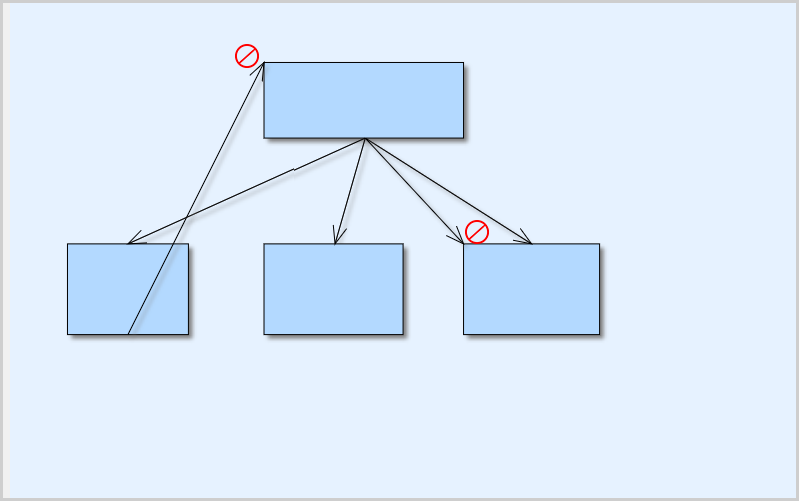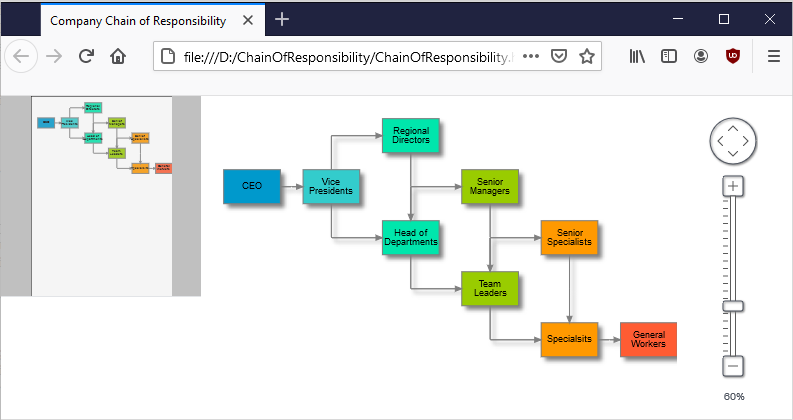This post demonstrates MindFusion.Diagramming API functionality that let you traverse connected diagram elements (following incident edges and adjacent nodes in graph-theory terminology). A diagram is treated as directed graph, where each node exposes incomingLinks and outgoingLinks collection properties, and respectively each link exposes origin and destination node properties. Thus the classic breadth-first search algorithm can be implemented like this for a diagram, with the callback parameter being invoked for each node, also reporting visit order and distance from initial node (as in length of shortest path in the graph):
Tag Archives: flowchart
Save and Load Part of Diagram Data to/from JSON Files
In this blog post we will demonstrate how you can implement methods that save and load part of the information that a diagram renders into JSON format. The Diagram class has built-in toJson and fromJson methods. They serialize completely the diagram with every detail so you can restore it completely, exactly the way you see it. What we are going to do is write custom save and load methods that use only part of the information – namely the size and location of nodes and links as well as their text.
One-way Links in Diagramming for JavaScript
In this blog post we demonstrate how you can use the JavaScript Diagram library to allow users to draw an org chart or one-way graph. By default, users are allowed to draw links between any two nodes and the count of links is unlimited. We will use event and properties, available in JS Diagram to allow users to:
– draw only one link between two nodes
– draw links only in one direction.
This behavior mirrors the hierarchy of an organization: in general , each employee, represented by a node, should have only one direct boss.
Chain Of Responsibility Diagram
We will build a diagram where we will arrange the nodes in a hierarchical manner to visualize the chain of responsibility in a company. We use the JavaScript Diagramming library, the TreeLayout and custom AnchorPattern definitions for nodes. Here is the final result:
JavaScript Diagram with Chart Nodes
In this blog post we will create DiagramNode instances that render a chart. The charts get resized according to the size of the node. We will use two MindFusion libraries for JavaScript – Charting and Diagramming. You can run the sample online from this link:
I. Project Setup
We will use a web page that will hold the HTML Canvas element that we need in order to render the diagram:
<div style="width: 100%; height: 100%; overflow: scroll;"> <canvas id="diagram" width="2100" height="2100" style="background:#f0f0f0;"> This page requires a browser that supports HTML 5 Canvas element. </canvas> </div>
We give the diagram’s Canavs big width and height and we also provide an id. The id is important because we will need to access the Canvas from code.
We add the scripts that we need in order to use the Charting and Diagramming libraries:
<script src="Scripts/MindFusion.Common.js" type="text/javascript"></script> <script src="Scripts/MindFusion.Diagramming.js" type="text/javascript"></script> <script src="Scripts/MindFusion.Charting.js" type="text/javascript"></script>
We add the references at the end of the web page, just before the closing BODY tag. We also need to add a reference to a JavaScript file that will hold the code for our sample. We name it “PieNode.js”.
II. The Diagram
In the code-behind file we create a diagram instance. We use the DOMContentLoaded event to initialize our diagram:
document.addEventListener("DOMContentLoaded", function ()
{
// create a Diagram component that wraps the "diagram" canvas
diagram = MindFusion.Diagramming.Diagram.create(document.getElementById("diagram"));
diagram.setBehavior(MindFusion.Diagramming.Behavior.LinkShapes);
diagram.setLinkHeadShapeSize(2);
diagram.setBounds(new Rect(0, 0, 2000, 2000));
// draw a pie when the user creates a node
diagram.addEventListener(Events.nodeCreated, onNodeCreated);
});
The Behavior enumeration lists various modes of behavior for the diagram. We choose Behavior.LinkShapes, which creates nodes, when the mouse is dragged
over an empty area and connects the nodes if the mouse is dragged from an existing node. We set tbe bounds of the diagram to a big Rect which guarantees that the user can draw nodes anywhere on the visible area. When the user draws towards the edge of the browser, the diagram control expands automatically.
Finally, we add an event handler for the nodeCreated event.
//nodeCreated event handler
function onNodeCreated(sender, args)
{
var node = args.getNode();
var nBounds = node.getBounds ();
var topLeftCoord = diagram.docToClient(nBounds.topLeft());
var bottomRightCoord = diagram.docToClient(nBounds.bottomRight());
.......................................................
}
At first we get the node that was created. Then we need to get its actual size, for which we use the docToClient method that converts between diagram and browser measure units. We get the two coordinates of the node’s bounding rectangle.
We create then a Canvas, which takes the size of the node’s rectangle:
............................................
.....................................................
var pieChartCanvas = document.createElement('canvas');
pieChartCanvas.width = bottomRightCoord.x - topLeftCoord.x;
pieChartCanvas.height = bottomRightCoord.y - topLeftCoord.y;
We then add this temp canvas to the body of the web page and call a method “createPie” where we draw the pie chart. Once the chart is drawn we get the URL of the image and set is to the node with the setImageLocation method. We remove the Canvas from the tree with the elements because we want to use for the next node.
//create a temporary Canvas for the pie chart //to draw itself upon document.body.appendChild(pieChartCanvas); createPie(pieChartCanvas); var pieImageLocation = pieChartCanvas.toDataURL(); node.setImageLocation(pieImageLocation); document.body.removeChild(pieChartCanvas);
III. The Chart
We create a pie chart in the Canvas provided to the createPie method:
//draw a pie chart on the provided canvas
function createPie(pieChartCanvas)
{
var pieChart = new Controls.PieChart(pieChartCanvas);
pieChart.startAngle = 45;
pieChart.showLegend = false;
pieChart.title = "Sales";
pieChart.titleMargin = new Charting.Margins(0, 10, 0, 0);
pieChart.chartPadding = 3;
...........................
We set some appearance properties to make the chart look the way we want – change the start angle of the pie, add a title and title margin, hide the legend. Then we create a PieSeries which holds the data and the labels of the pie. We assign the PieSeries to the series property of the pie chart:
// create sample data var values = new Collections.List([20.00, 30.00, 15.00, 40.00]); pieChart.series = new Charting.PieSeries( values, new Collections.List(["20", "30", "15", "40"]), null);
We style the chart with an instance of the PerElementSeriesStyle class, which colors all elements of a Series with the consequtive Brush and stroke from its brushes and strokes collections. Then we adjust the dataLabelsFontSize to match the size of the canvas. We make the labels be drawn with a white brush using the dataLabelsBrush property. Finally we call draw to render the pie.
var brushes = new Collections.List(
[
new Drawing.Brush("#0455BF"),
new Drawing.Brush("#033E8C"),
new Drawing.Brush("#F24405"),
new Drawing.Brush("#F21905")
]);
var seriesBrushes = new Collections.List();
seriesBrushes.add(brushes);
var strokes = new Collections.List(
[
new Drawing.Brush("#c0c0c0")
]);
var seriesStrokes = new Collections.List();
seriesStrokes.add(strokes);
pieChart.plot.seriesStyle = new Charting.PerElementSeriesStyle(seriesBrushes, seriesStrokes);
pieChart.theme.highlightStroke = new Drawing.Brush("#000063");
pieChart.theme.dataLabelsFontSize = pieChartCanvas.height/20;
pieChart.theme.dataLabelsBrush = new Drawing.Brush("#FFFFFF");
pieChart.draw();
And with that the sample is ready. You can download the source code together with all MindFusion JavaScript libraries used from:
https://mindfusion.eu/samples/javascript/diagram/PieNodes.zip
About Diagramming for JavaScript: This native JavaScript library provides developers with the ability to create and customize any type of diagram, decision tree, flowchart, class hierarchy, graph, genealogy tree and more. The control offers rich event set, numerous customization options, animations, graph operations, styling and themes. You have more than 100 predefined nodes, table nodes and more than 15 automatic layout algorithms. Learn more about Diagramming for JavaScript at https://mindfusion.eu/javascript-diagram.html.
About Charting for JavaScript: MindFusion library for interactive charts and gauges. It supports all common chart types including 3D bar charts. Charts can have a grid, a legend, unlimited number of axes and series. Scroll, zoom and pan are supported out of the box. You can easily create your own chart series by implementing the Series interface.
The gauges library is part of Charting for JavaScript. It supports oval and linear gauge with several types of labels and ticks. Various samples show you how the implement the gauges to create and customize all popular gauge types: car dashboard, clock, thermometer, compass etc. Learn more about Charting and Gauges for JavaScript at https://mindfusion.eu/javascript-chart.html.




